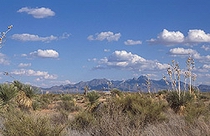This research included contributions from nine other ARS scientists, four U.S. Forest Service scientists, and colleagues from the University of Arizona, the University of California-Irvine, and UTS. ARS is USDA's chief intramural scientific research agency, and this research supports the USDA priority of responding to climate change.

"In the United States, much of our agricultural productivity has depended on long-term precipitation regimes. But those patterns are changing and we need information for managing the effects of those shifts," said ARS Administrator Edward B. Knipling. "These findings can help managers respond to the challenges of global climate change with effective strategies for maintaining agricultural productivity."
The researchers conducted their investigation using measurements made during 2000-2009 at 29 sites in the United States, Puerto Rico, and Australia. This provided data about precipitation patterns in environments ranging from grasslands to forests. Globally, the 2000-2009 decade ranked as the 10 warmest years of the 130-year (1880-2009) record. The team compared these data with measurements taken from 1975 to 1998 at 14 sites in North America, Central America, and South America.
To calculate ecosystem water use, the scientists used satellite observations to approximate aboveground net plant productivity at each site. Then they combined these approximations with field data of precipitation and estimates of plant water loss to generate indicators of plant water use efficiency.
The researchers observed that ecosystem water-use efficiency increased in the driest years and decreased in the wettest years. This suggests that plant water demand fluctuated in accordance with water availability and that there is a cross-community capacity for tolerating low precipitation and responding to high precipitation during periods of warm drought.
However, the team observed that the water-use efficiency data exhibited a trend of "diminishing returns." This suggests plant communities will eventually approach a water-use efficiency threshold that will disrupt plant water use and severely limit plant production when drought is prolonged.
The scientists also used the data to develop predictions about future plant response to climate changes. Their results suggest that ecosystem resilience will decline as regions are subjected to continuing warming and drying trends. They project that this downturn will begin in grassland biomes because these plant communities are particularly sensitive to the hot and dry conditions of prolonged warm droughts.
This work can help resource managers develop agricultural production strategies that incorporate changes in water availability linked to changing precipitation patterns.
ARS conducts research to develop and transfer solutions to help answer agricultural questions that impact Americans every day. ARS work helps to ensure high-quality, safe food and other agricultural products; assess the nutritional needs of Americans; sustain a competitive agricultural economy; enhance the natural resource base and the environment, and provide economic opportunities for rural citizens, communities and society as a whole.





